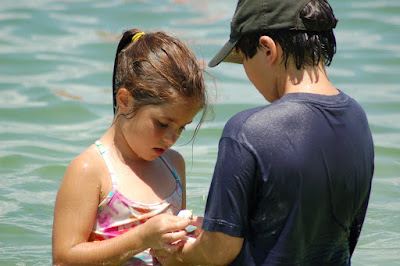
Last week, Sanibel Skills campers found ways to link up with the past. We went to the time of the Mighty Caloosa…perhaps more than 250 years ago. We learned about those sophisticated people; we learned to tie Sheet Bend knots (sometimes called Weaver’s knots); just like the Caloosa used to make their seines nets. We made dippers from cockle shells and sticks. We honed our canoe paddling skills in honor of their canoe-paddling tradition. Many of us adorned our bodies with henna tattoos in patterns similar to those of the Caloosa. While paddling, some of us were treated to a long, friendly visit from a Bottlenose Dolphin and her calf.
We went to sites known to have had Caloosa inhabitants and seined just as they probably did hundreds of years ago. While there, we were lucky enough to find some net weights fashioned from clam shells. Doing and finding have a way of bringing history to life – more than one gasp was uttered when artifacts were found and shared.
And, all week we spent time looking for natural objects that might be useful in the lives of our Sanibel predecessors. All this searching paid off on Thursday. That afternoon, we had a large game on the Bailey Tract. After a long hike, two Sanibel Sea School tribes met and traded items of value or utility. Then they went their separate ways and used their collections to make small totems along the paths that would have made any Caloosa’s spirits soar. After a hard decision, the totem judges deemed the Seahorse Tribe as the best totem builders of the week.
But each day, after lunch, we did deviate from the early inhabitants and hopped aboard our fiberglass and foam surfboards for our daily surfboard paddling at the end of Buttonwood ; fun, exercise and spirited competition.
But each day, after lunch, we did deviate from the early inhabitants and hopped aboard our fiberglass and foam surfboards for our daily surfboard paddling at the end of Buttonwood ; fun, exercise and spirited competition.
For the finale, parents, families and friends joined us for milk and cookies and a Friday night beach walk and seining on San Carlos Bay. There is just nothing like wrapping up a fun-filled week with a night-time swim down on the east end of our little island.
Next week, we will come back to the present and experience a few things about Manatees.

